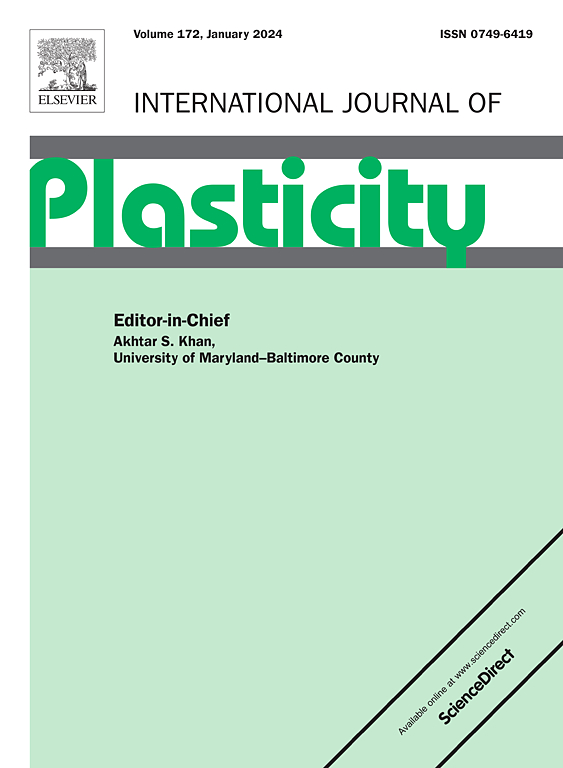A strain-path dependent unified constitutive model of titanium alloy coupling coarse grain subdivision and recrystallization: Application to multi-directional hot deformation
IF 9.4
1区 材料科学
Q1 ENGINEERING, MECHANICAL
引用次数: 0
Abstract
Primary hot working, represented by multi-directional hot forging and annealing, is a crucial step in microstructure control and plays a decisive role in the ultimate performance of ultra-high strength titanium alloy components. However, the interaction mechanisms of multiple physical processes comprising work hardening, dynamic recovery, dynamic recrystallization and grain fragmentation under complex thermo-mechanical routes are not yet well known, which greatly limits the process optimization and control of primary hot working process. In order to accurately predict the macro-micro behaviors of coarse-grained titanium alloys during multi-directional hot deformation and annealing processes, a strain-path dependent unified constitutive model was established comprehensively considering the intragranular coarse grain subdivision (ICGS) caused by ribbon and transgranular subdivided continuous dynamic recrystallization (CDRX), as well as the boundary-based coarse grain subdivision (BCGS) composed of discontinuous dynamic recrystallization (DDRX) coupled with boundary expand CDRX, and the interaction of various mechanisms under dislocation configuration. Through the combination of large deformation framework and viscoplastic theory, the influence of thermo-mechanical loading path and strain rate on grain refinement efficiency was elucidated. In the present model, the cumulative effects of loading direction changes on the degree of grain fragmentation were well identified by defining a new geometric parameter, viz. the loading axis rotation angle of the passes. The ICGS mechanism was introduced to the grain evolution model for the first time, by establishing a quatitative correlation between shear strain and the volume fraction of grain internal subdivision. In this way, the through-process precision prediction of the refinement degree of characteristic regions under multi-directional deformation paths was finally realized by combining BCGS and ICGS mechanisms, and the evolution of mechanical behaviors and internal variables in the alternating multi-directional hot deformation with heat preservation were simulated. The predictive results of the model were consistent with experiments of the titanium alloy with an average error of 4.93% and the refinement degrees of coarse-grained structures under different strain rates, temperatures and cumulative multi-directional large strains were well captured. Moreover, the applicable grain size range of the present constitutive model within a wide strain range was extended to 4 orders of magnitude (from micrometer to centimeter), and the effectiveness of the model in identifying complex multi-directional loading, multiple annealing and the heredity of internal variables during primary hot deformation were validated.
基于应变路径的钛合金粗晶细分与再结晶耦合统一本构模型在多向热变形中的应用
以多向热锻和退火为代表的一次热加工是组织控制的关键步骤,对超高强度钛合金部件的极限性能起着决定性的作用。然而,复杂热机械路径下加工硬化、动态恢复、动态再结晶和晶粒碎裂等多个物理过程的相互作用机制尚不清楚,这极大地限制了一次热加工过程的工艺优化和控制。为了准确预测粗晶钛合金在多向热变形和退火过程中的宏微观行为,综合考虑带状和穿晶细分连续动态再结晶(CDRX)引起的晶内粗晶细分(ICGS),建立了基于应变路径的统一本构模型。以及由不连续动态再结晶(DDRX)和边界扩展CDRX组成的基于边界的粗晶粒细分(BCGS),以及位错配置下各种机制的相互作用。通过结合大变形框架和粘塑性理论,阐明了热-机械加载路径和应变速率对晶粒细化效率的影响。在该模型中,通过定义一个新的几何参数,即孔道的加载轴旋转角度,很好地识别了加载方向变化对颗粒破碎程度的累积效应。通过建立剪切应变与晶粒内部细分体积分数之间的定量关系,首次将ICGS机制引入到晶粒演化模型中。这样,结合BCGS和ICGS机制,最终实现了多向变形路径下特征区域细化程度的全程精度预测,并模拟了多向热变形与保温交替过程中力学行为和内部变量的演变。该模型的预测结果与钛合金的实验结果一致,平均误差为4.93%,较好地反映了不同应变速率、温度和累积多向大应变下粗晶组织的细化程度。将本构模型在宽应变范围内的适用晶粒尺寸范围扩展到4个数量级(从微米到厘米),验证了该模型在识别复杂多向加载、多次退火和初次热变形过程中内部变量遗传方面的有效性。
本文章由计算机程序翻译,如有差异,请以英文原文为准。
求助全文
约1分钟内获得全文
求助全文
来源期刊

International Journal of Plasticity
工程技术-材料科学:综合
CiteScore
15.30
自引率
26.50%
发文量
256
审稿时长
46 days
期刊介绍:
International Journal of Plasticity aims to present original research encompassing all facets of plastic deformation, damage, and fracture behavior in both isotropic and anisotropic solids. This includes exploring the thermodynamics of plasticity and fracture, continuum theory, and macroscopic as well as microscopic phenomena.
Topics of interest span the plastic behavior of single crystals and polycrystalline metals, ceramics, rocks, soils, composites, nanocrystalline and microelectronics materials, shape memory alloys, ferroelectric ceramics, thin films, and polymers. Additionally, the journal covers plasticity aspects of failure and fracture mechanics. Contributions involving significant experimental, numerical, or theoretical advancements that enhance the understanding of the plastic behavior of solids are particularly valued. Papers addressing the modeling of finite nonlinear elastic deformation, bearing similarities to the modeling of plastic deformation, are also welcomed.
 求助内容:
求助内容: 应助结果提醒方式:
应助结果提醒方式:


